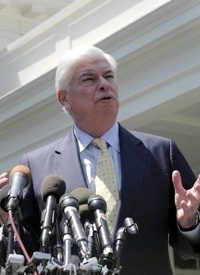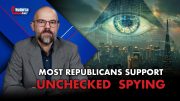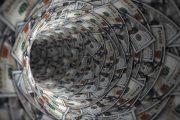
When the House passed the 2,319-page Dodd-Frank financial reform bill by a vote of 237-192, all it did was confirm for many the extraordinary hubris of legislators believing they could in fact “fix” the problems they themselves created which resulted in the Great Recession of 2008.
John B. Taylor, professor of economics at Stanford University says, “The main problem with the bill is that is based on a misdiagnosis of the causes of the financial crisis … the presumption that the government did not [already] have enough power to avoid the crisis.” Instead of attempting to make existing government regulations more effective, he said, “the bill vastly increases the power of government in ways that are unrelated to the [present] crisis and may even encourage future crises.”
According to Senator Chris Dodd (D-Conn., above), the reason for the financial reform bill is to “create a sound economic foundation to grow jobs, protect consumers, rein in Wall Street, end ‘Too Big to Fail,’ [and] prevent another financial crisis.” It will in fact do none of these.
The real agenda is to strengthen the federal government’s control over what’s left of the market economy. As Charles Scaliger wrote recently, this bill “differs not a whit in principle from previous attempts to Washington … to vanquish various free-market hobgoblins by government regimentation.” Peter Schiff, candidate for Dodd’s seat in Connecticut, said the bill will “not only … do nothing to prevent the [next] crisis, it will more than likely increase its severity.” Taylor confirms that by stating flatly that “the bill does not do what its supporters claim. It does not prevent future financial crises. Rather, it makes them more likely and in the meantime impedes economic growth.”
Especially annoying is the continued promotion of the falsehood that it was the free market that caused the Great Recession, including large-scale misallocations of capital, excessive aggregations of such capital in private hands, booms and busts caused by the free market, and secret and dishonest dealings among and between those wealthy and powerful capitalists. Thomas Woods makes clear in his book Meltdown that it was precisely government intervention, regulation, and favoritism that caused the current crisis, and not the free market. Gary North put it this way: “The bill is supposedly designed to prevent a replay of the 2008 crisis, in which 75 years of Federal financial reform laws proved utterly useless in preventing.”
Protecting Consumers
Many remember the television advertisements paid for by the U.S. Chamber of Commerce showing a butcher with his hands folded, standing in front of a big pile of meat. The voice-over said, “The economy has made it tough on this local butcher’s customers. So he lets some of them run a tab and pay the bill over time to make ends meet. But now Washington [in the name of consumer protection] wants to make it tougher [for him to offer such assistance because he is now in the ‘finance’ business]."
What a part of the bill does is allow a new agency (to be housed inside the Federal Reserve) to impose a welter of new burdens on all businesses that offer credit of one sort or another, including installment plans and layaways. President Obama supported this new agency with these soothing words from Big Brother: “From now on, every consumer will be empowered with the clear and concise information that you need to make financial decisions that are best for you.” Professor Taylor responds: “The new bureau will write rules for every type of financial service, most of which (such as payday loans) have no conceivable connection with the crisis.”
Ending “Too Big to Fail”
The bill gives “resolution authority” to the Treasury Department, the FDIC, and the Federal Reserve to “deal with” the insolvency of mega-financial institutions. According to Moody’s Investors Service, that the bill would permanently end any idea that firms somehow are “too big to fail” does no such thing.
The risks … would not be completely eliminated … and the incentives and tools … to provide support via emergency liquidity … would continue to be part of the framework.
Taylor concurs: “The problem of ‘too big to fail’ remains, and any cozy relationship between certain large financial institutions and the government that existed before the crisis will continue.” (Emphasis added.)
Reining In Derivatives
The derivatives market is huge almost beyond comprehension, now approaching $700 trillion annually. The bill would purportedly force banks to sell off their derivatives operations if they wanted to keep their guarantees under the FDIC. Since these operations generate most of the banks’ profits, there was great resistance to the idea. Matt Taibbi, in an excoriating, vitriolic and often obscene piece that appeared in Rolling Stone magazine on June 10, built a persuasive case that lobbyists for the big banks “earned their money” by inserting a loophole that would allow such banks to keep their derivatives operations after all. Taibbi said, “Taken together, [these] hundreds of pages of rigid rules [include] a few cleverly concealed clauses that make [violating] those rules no big deal.”
Agreeing with Taibbi is Michael Greenberger, a former official with the Commodity Futures Trading Commission, who describes the textual trickery as a “circle of doom. Despite the pages and pages of regulations, violating them is risk-free.”
Audit the Fed
Rep. Ron Paul garnered 319 co-sponsors of his House bill to audit the Fed, but it was gutted by a Senate bill offered by democratic socialist Senator Bernie Sanders. If the bill passes the Senate next week, as expected, there will be a single, one-time only audit of the Fed’s behavior during the economic crisis.
The biggest impact of this bill in its present form is that the Fed, rather than having its powers trimmed, will enjoy expansive new ones. Its new “resolution authority” to “preside over bankruptcy proceedings would involve the executive branch in what has previously been a responsibility of the judicial branch,” according to Charles Scaliger. As he concludes, “The bill makes no effort to rein in the Federal Reserve, choosing instead … to greatly expand its powers. The message: The blame for the economic crisis is to be placed squarely on the private sector, with the government … refusing to acknowledge an iota of accountability for a calamity that is, in fact, entirely a creation of the state.”
Fannie Mae, Freddie Mac, and CRA (Community Reinvestment Act)
Not a single word in the bill mentions these three critical players in the current Great Recession. Yet each of them provided vital impetus to pushing loans to sub-prime borrowers who later defaulted. Such is the ultimate hubris of the legislation: even suggesting that future crises can be avoided without addressing the major players in the current one.
Putting this bill that expands government powers where there is no constitutional authority to do so into perspective, it is helpful to quote from the Declaration of Independence: “But when a long Train of Abuses and Usurpations, pursuing invariably the same Object, evinces a Design to reduce them under absolute Despotism, it is their Right, it is their Duty, to throw off such Government…. The History of the present King of Great-Britain is a History of repeated Injuries and Usurpations, all having in direct Object the Establishment of an absolute Tyranny over these States [such injuries including the erection of] a Multitude of new Offices, and [sending] hither Swarms of Officers to harass our People, and eat out their Substance.”
Even to the most casual observer of the times, it is becoming clear what the underlying purpose of such legislation is: namely to create a Tyranny of government regulation, rules and laws that, in the end, turn citizens into subjects.
Photo: Senate Banking Committee Chairman Sen. Christopher Dodd, (D-Conn.) spoke to reporters with House Financial Services Committee Chairman Rep. Barney Frank (D-Mass., out of picture) outside the White House on May 21, 2010, after meeting with President Obama: AP Images



